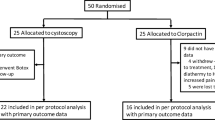Abstract
Introduction and hypothesis
For decades, intravesical dimethyl sulfoxide (DMSO) cocktail therapy has been used for the treatment of interstitial cystitis/bladder pain syndrome (IC/BPS), but little is known about its long-term efficacy. We aimed to assess the long-term efficacy of intravesical DMSO/heparin/hydrocortisone/bupivacaine therapy in patients with IC/BPS.
Methods
Patients with IC/BPS from our institutions who underwent this therapy with >2 years follow-up were surveyed with O’Leary–Sant interstitial cystitis symptom and problem index questionnaires before and after therapy. Chart reviews and telephone surveys were then conducted to determine their posttherapy course.
Results
Of 68 eligible women, 55 (80.0%) with a median follow-up of 60 months (range 24–142) were surveyed. Their mean age at therapy onset was 44.8 years and their mean body mass index was 26.2 kg/m2. There were statistically significant improvements in O’Leary–Sant and pain scores of 23–47% at both 6 weeks and the end of the follow-up period. At the end of the follow-up period, 19 of the 55 women (34.5%) were cured (requiring no further treatment) and 12 (21.8%) were significantly improved (requiring only ongoing oral medication). Univariate and multivariate analyses showed that DMSO treatment failure was more likely in patients with pretreatment day-time urinary frequency more than 15 episodes per day (OR 1.41), nocturia more than two episodes per night (OR 2.47), maximum bladder diary voided volume <200 ml (OR 1.39) and bladder capacity under anaesthesia <500 ml (OR 1.6).
Conclusions
At a median follow-up of 60 months, intravesical DMSO cocktail therapy appeared moderately effective for the treatment of IC/BPS. Treatment failure was more frequent in patients with pretreatment symptoms of reduced bladder capacity.
Similar content being viewed by others
References
Hanno PM, Erickson D, Moldwin R, Faraday MM, American Urological Association. Diagnosis and treatment of interstitial cystitis/bladder pain syndrome: AUA guideline amendment. J Urol. 2015;193(5):1545–1553.
Curhan GC, Speizer FE, Hunter DJ, Curhan SG, Stampfer MJ. Epidemiology of interstitial cystitis: a population based study. J Urol. 1999;161:549–552.
Ibrahim IA, Diokno AC, Killinger KA, Carrico DJ, Peters KM. Prevalence of self-reported interstitial cystitis (IC) and interstitial-cystitis-like symptoms among adult women in the community. Int Urol Nephrol. 2007;39:489–495.
Berry SH, Stoto MA, Elliot M, Suttorp M, Bogart L, Eggers PW, et al. Prevalence of interstitial cystitis/painful bladder syndrome in the United States. J Urol. 2009;181(4 Suppl):20–21.
Shirley SW, Stewart BH, Mirelman S. Dimethyl sulfoxide in treatment of inflammatory genitourinary disorders. Urology. 1978;11:215–220.
Ghoneim GM, McBride D, Sood OP, Lewis V. Clinical experience with multiagent intravesical therapy in interstitial cystitis patients unresponsive to single-agent therapy. World J Urol. 1993;11:178–182.
Parkin J, Shea C, Sant GR. Intravesical dimethyl sulfoxide for interstitial cystitis – a practical approach. Urology. 1997;49(5A Suppl):105–107.
Rössberger J, Fall M, Peeker R. Critical appraisal of dimethyl sulfoxide treatment for interstitial cystitis: discomfort, side-effects and treatment outcome. Scand J Urol Nephrol. 2005;39(1):73–77.
Gafni-Kane A, Botros SM, Du H, Sand RI, Sand PK. Measuring the success of combined intravesical dimethyl sulfoxide and triamcinolone for treatment of bladder pain syndrome/interstitial cystitis. Int Urogynecol J. 2013;24:303–311.
Hung M, Chen Y, Shen P, Hsu S, Chen G, Ho E. Risk factors that affect the treatment of interstitial cystitis using intravesical therapy with a dimethyl sulfoxide cocktail. Int Urogynecol J. 2012;23:1533–1539.
Stav K, Beberashvili I, Lindner A, Leibovici D. Predictors of response to intravesical dimethyl-sulfoxide cocktail in patients with interstitial cystitis. Urology. 2012;80(1):61–65.
van Ophoven A, Hertle L. Long-term results of amitriptyline treatment for interstitial cystitis. J Urol. 2005;174(5):1837–1840.
Al-Zahrani AA, Gajewski JB. Long-term efficacy and tolerability of pentosan polysulphate sodium in the treatment of bladder pain syndrome. Can Urol Assoc J. 2011;5(2):113–118.
Sairanen J, Forsell T, Ruutu M. Long-term outcome of patients with interstitial cystitis treated with low dose cyclosporine A. J Urol. 2004;171(6 Pt 1):2138–2141.
Hillelsohn JH, Rais-Bahrami S, Friedlander JI, Okhunov Z, Kashan M, Rosen L, Moldwin RM. Fulguration for Hunner ulcers: long-term clinical outcomes. J Urol. 2012;188(6):2238–2241.
Engelhardt PF, Morakis N, Daha LK, Esterbauer B, Riedl CR. Long-term results of intravesical hyaluronan therapy in bladder pain syndrome/interstitial cystitis. Int Urogynecol J. 2011;22(4):401–405.
Kallestrup EB, Jorgensen SS, Nordling J, Hald T. Treatment of interstitial cystitis with Cystistat: a hyaluronic acid product. Scand J Urol Nephrol. 2005;39(2):143–147.
Pinto R, Lopes T, Frias B, Silva A, Silva JA, Silva CM, et al. Trigonal injection of botulinum toxin A in patients with refractory bladder pain syndrome/interstitial cystitis. Eur Urol. 2010;58:360–365.
Lee CL, Kuo HC. Long-term efficacy and safety of repeated intravesical onabotulinumtoxinA injections plus hydrodistention in the treatment of interstitial cystitis/bladder pain syndrome. Toxins (Basel). 2015;7(10):4283–4293.
Ghazwani YQ, Elkelini MS, Hassouna MM. Efficacy of sacral neuromodulation in treatment of bladder pain syndrome: long-term follow-up. Neurourol Urodyn. 2011;30(7):1271–1275.
Author information
Authors and Affiliations
Corresponding author
Ethics declarations
Funding
None.
Conflicts of interest
The authors have received research grants from AMS & Boston Scientific for other studies not related to this study.
Ethical approval
Approval for data collection was provided by Mercy Health Human Research & Ethics Committee (R15/02).
Rights and permissions
About this article
Cite this article
Lim, Y.N., Dwyer, P., Murray, C. et al. Long-term outcomes of intravesical dimethyl sulfoxide/heparin/hydrocortisone therapy for interstitial cystitis/bladder pain syndrome. Int Urogynecol J 28, 1085–1089 (2017). https://doi.org/10.1007/s00192-016-3232-0
Received:
Accepted:
Published:
Issue Date:
DOI: https://doi.org/10.1007/s00192-016-3232-0




